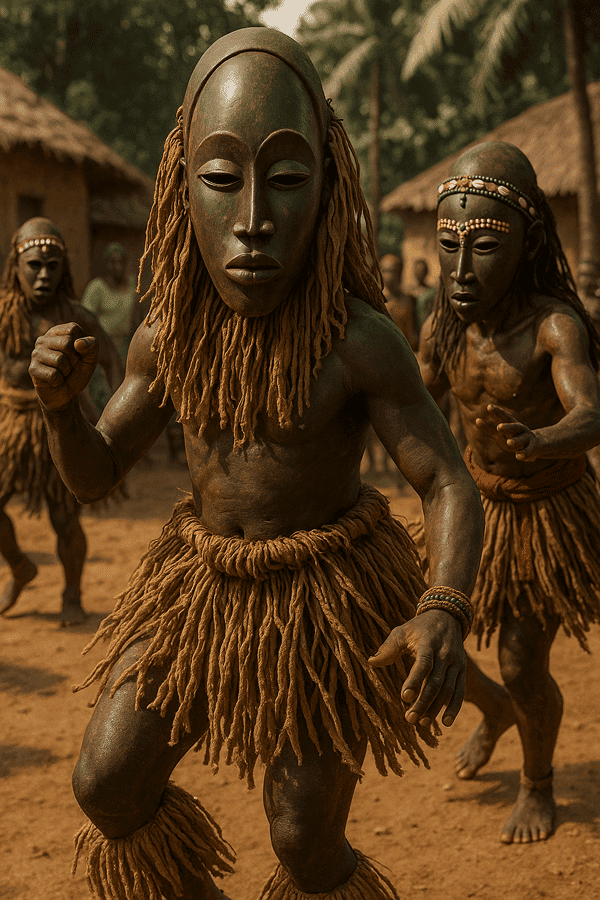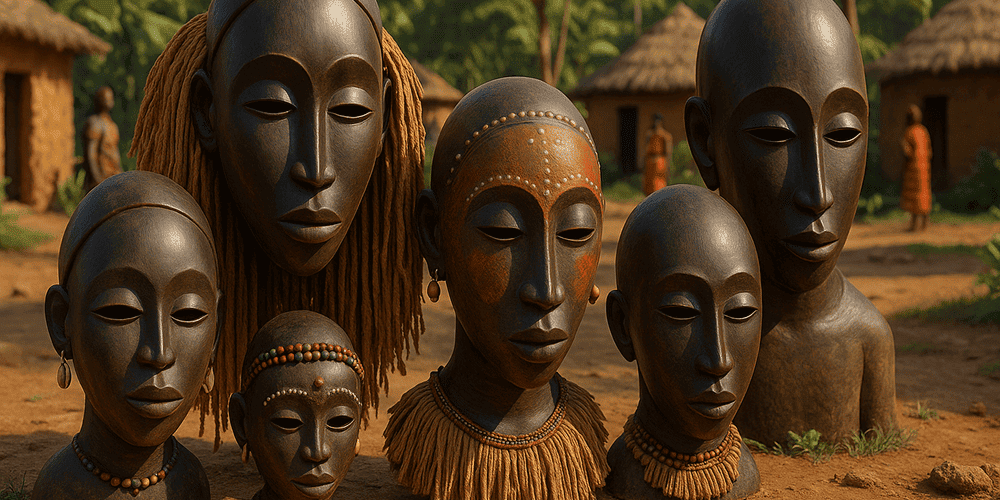Dan Tribe Masks, also known as Dan Masks, stand out as some of the most iconic and expressive artifacts of West African art. Originating from the Dan people, who inhabit the border regions of present-day Liberia and Côte d’Ivoire, these masks are instantly recognizable for their elegant, elongated forms, prominent lips, and oval-shaped eyes. Dan Tribe Masks are celebrated for their harmonious proportions, smooth wooden surfaces, and the deep spiritual meanings they embody. Each mask is unique, reflecting both the individual carver’s artistry and the specific social or ritual function it is designed to fulfill. The tradition of Dan Mask-making is centuries old, rooted in the rich cultural and spiritual heritage of the Dan people.
Historical Origins: The Evolution of Dan Tribe Masks
The origins of Dan Tribe Masks lie deep in the history of the Dan people, whose ancestors migrated to the forested regions of West Africa several hundred years ago. The name “Dan” refers to the ethnic group itself, while the masks are often given specific titles based on their role or the spirit they represent. Historical records and oral traditions suggest that Dan Mask-making dates back at least to the 18th century, with earlier roots in migratory rituals and ancestral worship. Over time, the design and function of Dan Masks evolved, influenced by inter-tribal contact, trade, and changing religious beliefs. Significant historical references include 19th-century ethnographic accounts and preserved masks found in regional shrines. The evolution of Dan Masks demonstrates both continuity and adaptation, a theme shared with other West African mask traditions such as Yoruba Masks.
Cultural Significance and Symbolism: The Meaning of Dan Tribe Masks
Dan Tribe Masks are much more than decorative objects; they are powerful symbols of spiritual and social identity. Each mask is believed to embody a specific spirit, known as a “ge,” which acts as a mediator between the community and the supernatural world. In Dan culture, masks are used to invoke protection, ensure fertility, settle disputes, and celebrate important milestones. The act of wearing a Dan Mask is considered a sacred responsibility, involving rituals of purification and spiritual preparation. Myths and legends surround many famous masks, attributing miraculous powers or heroic deeds to their spirits. In addition to their spiritual role, Dan Masks serve as vehicles for education, social cohesion, and the reinforcement of traditional values within the community.
Materials and Craftsmanship: Making Dan Tribe Masks
The creation of Dan Tribe Masks is a highly skilled craft, traditionally passed down through generations of master carvers. The primary material is wood — often from local hardwood trees — selected for its strength, grain, and spiritual properties. Artisans use adzes, knives, and chisels to carve the basic shape, followed by smoothing and finishing with natural oils or pigments. Special techniques, such as inlaying with metal, adding cowrie shells, or attaching raffia, beads, or animal hair, are used to enhance the mask’s appearance and symbolic meaning. Regional differences in craftsmanship exist: some masks feature more angular or abstract designs, while others are highly naturalistic. The color palette is typically earthy, with brown, black, and red dominating, though white kaolin clay may be used for symbolic highlights. Decorative motifs often reflect the mask’s intended function and the spirit it represents.
Functions and Use: Ritual and Social Roles of Dan Masks
Dan Tribe Masks play a central role in the ritual and social life of the Dan people. They are used in ceremonies that range from initiation rites and funerals to harvest festivals and legal proceedings. The most famous of these rituals is the “ge” masquerade, in which masked dancers perform complex choreography to invoke the presence of ancestral spirits and communicate their blessings or warnings. Dan Masks are also used in theatrical storytelling, serving as visual aids for myths, legends, and moral tales. Over time, the functions of Dan Masks have adapted to new contexts, including public festivals, art exhibitions, and educational programs. Today, Dan Masks are recognized as a vital part of West African cultural heritage and are collected by museums and art enthusiasts worldwide.

Regional Variations: Diversity Among Dan Tribe Masks
While Dan Tribe Masks share many common features, there is considerable regional variation in style, function, and symbolism. In the northern Dan regions, masks tend to be larger and more elaborate, with pronounced brows and intricate surface decoration. Southern Dan masks are often smaller, with a greater emphasis on refined carving and subtle expression. Unique local traditions may add animal motifs, geometric patterns, or specific color schemes. When compared to other African mask traditions, such as Yoruba Masks, Dan Masks are notable for their smooth, minimalist aesthetic and emphasis on idealized human forms. These distinctions highlight the diversity and creativity within West African mask-making.
Famous Examples and Collections: Where to See Dan Tribe Masks
Some of the most renowned Dan Tribe Masks are preserved in leading museums, including the Musée du Quai Branly in Paris, the British Museum, and the National Museum of Liberia. These institutions display masks from different periods and regions, offering insight into the evolution of Dan artistry. Historical finds include masks recovered from sacred groves, royal treasuries, and private collections. Notable private collections and galleries also feature rare and antique Dan Masks, many of which are considered masterpieces of African art. For those interested in exploring or acquiring Dan Tribe Masks, online platforms such as toddmasks.com provide educational resources and curated selections.
Influence on Art and Culture: Dan Tribe Masks in Global Creativity
Dan Tribe Masks have had a profound influence on both African and international art. Their harmonious forms and spiritual symbolism have inspired painters, sculptors, and designers around the world. Dan Masks appear in literature, film, and music, often symbolizing themes of transformation, identity, and ancestral connection. Their aesthetic has been referenced in modern design and fashion, while their role in ritual and performance has informed contemporary theatre and dance. The preservation and celebration of Dan Masks play a crucial role in sustaining African cultural identity and fostering cross-cultural dialogue. Their influence can be compared to that of Yoruba Masks, which also have a significant impact on art and culture.
Modern Status and Preservation: Contemporary Dan Masks and Tradition
Today, the tradition of Dan Mask-making is upheld by master carvers, cultural organizations, and local communities. Apprenticeship systems and workshops help transmit traditional skills to younger generations, while museums and festivals promote public appreciation. Modern adaptations include the use of new materials, innovative designs, and integration with digital media. Educational programs and masterclasses support the continued vitality of Dan Mask traditions, ensuring their relevance in the 21st century. Efforts to document, exhibit, and teach about Dan Tribe Masks contribute to the preservation of a unique and valuable aspect of African heritage.
Collecting and Acquisition: The Market for Dan Tribe Masks
The market for Dan Tribe Masks is active and diverse, encompassing both antique and contemporary examples. Authentic masks can be found in museums, private collections, and online galleries like toddmasks.com. Prices vary depending on age, craftsmanship, provenance, and ritual significance, with rare or ceremonial masks commanding higher values. Collectors are advised to seek documentation of authenticity, understand the cultural context, and support ethical sourcing practices. It is important to respect the spiritual and communal meanings of Dan Masks, ensuring that their acquisition benefits both the artisan and the cultural community.
